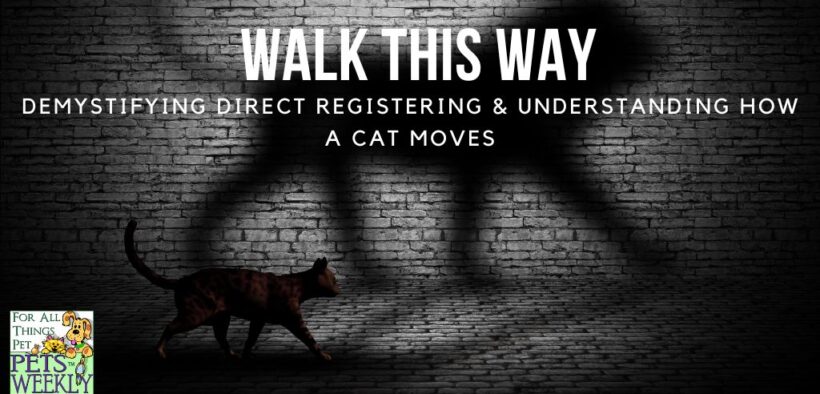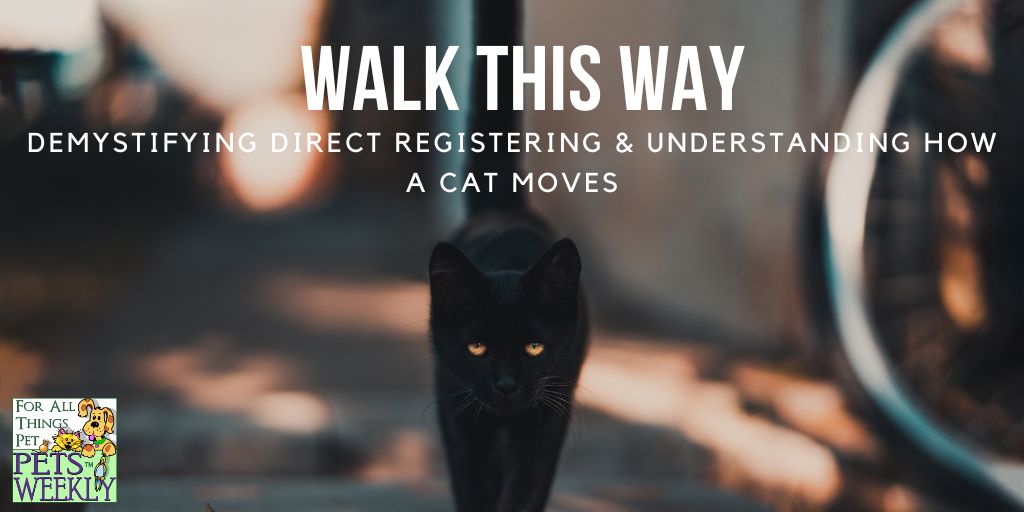How Cats Walk and Demystifying Direct Registering
Share

The feline form, a captivating tapestry of grace and agility, is as much a masterpiece of movement as it is of muscle and bone. Their gait, unlike any other beast, whispers of stealth and precision, a testament to their evolutionary legacy as apex hunters and silent stalkers. But beneath the surface of this seemingly effortless elegance lies a complex dance of limbs and nerves, governed by a biomechanical symphony that orchestrates each purring step. Let’s embark on a journey into the fascinating world of how cats walk, and unlock the secrets of their enigmatic signature move known as: Direct Registering.

A Ballet of Paws on Tiptoe – How Cats Walk on Their Toes
Unlike us lumbering bipeds, cats walk on their tiptoes, their delicate paws barely grazing the ground. This “digitigrade” posture, a shared trait among felines, allows for minimal noise and maximum control. Imagine a ballerina pirouetting on the tips of her toes, her every movement calculated and precise.
That’s the essence of a cat’s walk, a silent dance of feathered feet on the stage of life.
There is a perfectly good biological reason for these silent footfalls. Cats are predators. They need to be stealthy to catch their prey. So, when they are stalking a mouse or any other prey, the good hunters stay silent and swift. This can only truly be accomplished with the perfect balance of walking on tip toes.
This is also another reason why we consider it a crime to declaw a cat (and we don’t care if your cat is solely an indoor cat). The fact is, all cats have a natural way of moving and removing the equivalent of the top joint of their toes is – well, it’s animal abuse. But, back to the topic at hand…
The Rhythm of the Lateral Sequence in How Cats Walk
While humans (and most animals) move their limbs diagonally, cats waltz to a different beat. Their secret? The lateral sequence, where left and right legs move in unison, mirroring each other like dancers in a perfectly choreographed routine. This not only creates a smooth, rhythmic gait, but also contributes to their remarkable stability, even on treacherous terrain.
Think of it as a built-in balance beam, ensuring each step is steady and sure.
Wondering what the tracks look like? This site has some excellent images of cat tracks in mud and snow. It also examines how cats walk and the size of different types of cats in the wild (and in your home).
Enter the Enigma: Unveiling Direct Registering
Now, the curtain rises on the enigmatic Direct Registering, a captivating quirk in feline locomotion that has mystified scientists and cat lovers alike.
In this mesmerizing feat, each hind paw lands almost precisely in the footprint of the corresponding forepaw. This almost bipedal stride, reminiscent of a high-wire act performed with feline finesse, minimizes noise and leaves fewer tracks, making our furry friends masters of stealth.
It’s like a built-in silencer for kitty assassins, allowing them to vanish into the shadows or stalk their prey with the subtlety of a falling leaf.
Beyond the Silent Steps: Unveiling the Benefits of How Cats Walk
Direct Registering isn’t just about disappearing acts and cat-and-mouse games. This paw-some gait offers several hidden advantages:
- Efficiency Extraordinaire: This synchronized stride minimizes wasted energy. By placing their hind paws on pre-softened ground, cats reduce the need for additional force with each step, making them the picture of feline fuel efficiency.
- Stability Unshakeable: By landing on existing paw prints, the hind legs gain better grip and traction, providing crucial stability even on slippery or uneven surfaces. Imagine walking on a freshly raked gravel path – Direct Registering is like having built-in treads for your paws.
- Balance Beyond Belief: This synchronized paw placement helps maintain balance and agility, especially while turning or navigating tight corners. Think of it as a built-in gyroscope, ensuring your feline friend can navigate labyrinths and negotiate furniture with the grace of a seasoned tightrope walker.
Not Just for the Wild Ones: Domestic Delights
While Direct Registering is most prominent in wild felines like lions and tigers, our domestic companions sometimes exhibit this behavior too. You might notice your feline friend gliding with this stealthy stride in situations where they feel cautious or are on the hunt for a feathered toy. It’s like a dormant superpower waiting to be unleashed, a reminder of their wild ancestry even as they purr on your lap.
The Science Behind the Magic of How Cats Walk
But how do cats walk this way? The answer lies in a complex interplay of anatomy and neural control.
The feline spine plays a crucial role, its flexibility allowing for the synchronized movement of limbs.
Imagine a springy willow branch swaying in the breeze – that’s the essence of the feline spine, allowing for the precise paw placement of Direct Registering.
But, About That Spine…
A cat’s spine boasts a generous count of vertebrae. With a whopping 53 individual bones (compared to our lowly 33), each disc in this elongated chain provides extra room for rotation and bending. Between each vertebra lies a magical disc, not simply hard cartilage, but a springy cushion of fibrous tissue and a jelly-like center called the nucleus pulposus.
This is what helps them protect and cushion their spine during a long jump or fall. This elastic marvel acts as a shock absorber, allowing for effortless twisting and bending while providing crucial protection for the delicate spinal cord. Imagine these discs as tiny trampolines for each vertebra, propelling them into seemingly impossible contortions.
Unlike our tightly-knit spinal connections, the joints between a cat’s vertebrae are looser, held together by a web of muscles and ligaments. This allows for increased freedom of movement, permitting lateral bending, side-to-side twisting, and even a full 180-degree rotation of the torso – a party trick humans can only dream of! Picture each vertebra as a ball in a socket, not rigidly fixed, but free to dance within its range of motion.
Additionally, specialized nerve pathways in the spinal cord help coordinate the cat’s gait, acting as a conductor for this feline orchestra of movement.
From Paw Prints to Footprints: Unveiling the Evolutionary Story
Did cats always walk this way? Well, we can see evidence in our history.
The evolution of Direct Registering is a story etched in paw prints… Fossil evidence suggests that early felines, faced with fierce competition and the need for stealthy hunting, developed this gait as a way to minimize noise and leave fewer tracks.
For a predator, leaving a trail is like leaving a neon sign, so Direct Registering became a crucial adaptation for survival. How cats walk directly impact their hunting skills.
A Symphony of Movement: A Celebration of the Feline Gait
Now that you understand a bit more about how cats walk, you can see that is a testament to their evolutionary brilliance. Their mesmerizing blend of elegance, efficiency, and stealth guide their silent steps and agile movements. It speak volumes about their predatory past and their present-day prowess as curious explorers and mischievous housemates.











